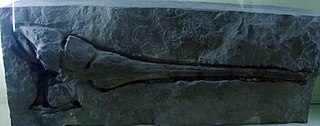
Mephitidae is a family of mammals comprising the skunks and stink badgers. They are noted for the great development of their anal scent glands, which they use to deter predators. Skunks were formerly classified as a subfamily of the Mustelidae ; however, recent genetic evidence has caused skunks to be treated as a separate family. Similarly, the stink badgers had been classified with badgers, but genetic evidence shows they share a more recent common ancestor with skunks, so they are now included in the skunk family. A 2017 study using retroposon markers indicated that they are most closely related to the Ailuridae and Procyonidae.

Crocodylinae is a subfamily of true crocodiles within the family Crocodylidae, and is the sister taxon to Osteolaeminae.

Caniformia is a suborder within the order Carnivora consisting of "dog-like" carnivorans. They include dogs, bears, raccoons, and mustelids. The Pinnipedia are also assigned to this group. The center of diversification for the Caniformia is North America and northern Eurasia. Caniformia stands in contrast to the other suborder of Carnivora, the Feliformia, the center of diversification of which was in Africa and southern Asia.

Pliopithecus {meaning "more ape") is a genus of extinct primates of the Miocene. It was discovered in 1837 by Édouard Lartet (1801–1871) in France, with fossils subsequently discovered in Switzerland, Slovakia and Spain.

Homo rhodesiensis is the species name proposed by Arthur Smith Woodward (1921) to classify Kabwe 1, a Middle Stone Age fossil recovered from a cave at Broken Hill, or Kabwe, Northern Rhodesia .. In 2020, the skull was dated to 324,000 to 274,000 years ago. Other similar older specimens also exist.

The Steinheim skull is a fossilized skull of a Homo neanderthalensis or Homo heidelbergensis found on 24 July 1933 near Steinheim an der Murr, Germany. It is estimated to be between 250,000 and 350,000 years old. The skull is slightly flattened and has a cranial capacity between 950 and 1280 cc. Sometimes referred to as Homo steinheimensis in older literature, the original fossil is housed in the State Museum of Natural History in Stuttgart, Germany. Some believe that the Steinheim skull may have belonged to an adult female due to its gracile nature.

The Togo mouse, also known as Büttner's African forest mouse or the groove-toothed forest mouse, is a unique muroid rodent known from only two specimens taken from near the type locality of Bismarckburg, near Yege, Togo, in 1890. Its genus is monotypic.
The genus Apidium is that of at least three extinct primates living in the early Oligocene, from 30 to 28 million years ago. Apidium fossils are common in the Fayoum deposits of Egypt. Fossils of the earlier species, Apidium moustafai, are rare; fossils of the later species Apidium phiomense are fairly common.

The Rodrigues rail, also known as Leguat's gelinote or Leguat's rail, is an extinct species of the rail family that was endemic to the Mascarene island of Rodrigues, east of Madagascar in the Indian Ocean. It is generally kept in its own genus, Erythromachus, but has sometimes been assigned to the genus Aphanapteryx along with its close relative the red rail of Mauritius; their relationship with other rails is unclear. The Rodrigues rail was about 35 cm (14 in) long and weighed at least 500 g (18 oz). It was described as having grey plumage, a red beak, red legs, and a naked red patch around the eye. The beak was long and curved downwards. It was flightless and fed on tortoise eggs. It was described as being attracted to red objects, which humans exploited while hunting it.

Paralouatta is a platyrrhine genus that currently contains two extinct species of small primates that lived on the island of Cuba.

Tremacebus is an extinct genus of New World monkeys from the Early Miocene. The type species is T. harringtoni.

The Neuropterida are a clade, sometimes placed at superorder level, of holometabolous insects with over 5,700 described species, containing the orders Neuroptera, Megaloptera, and Raphidioptera (snakeflies).

Humboldt's hog-nosed skunk, also known as the Patagonian hog-nosed skunk, is a type of hog-nosed skunk indigenous to the open grassy areas in the Patagonian regions of South Argentina and Chile. It belongs to the order Carnivora and the family Mephitidae.
Oligopithecidae is an extinct basal Catarrhine family from the late Eocene of Egypt as sister of the rest of the Catarrhines. Its members were probably insectivorous due to their simple molars and cusp arrangement.

The American hog-nosed skunk is a species of hog-nosed skunk from Central and North America, and is one of the largest skunks in the world, growing to lengths of up to 2.7 feet (82 cm). Recent work has concluded the western hog-nosed skunk is the same species, and Conepatus leuconotus is the correct name of the merged populations.

The Hominidae, whose members are known as the great apes or hominids, are a taxonomic family of primates that includes eight extant species in four genera: Pongo ; Gorilla ; Pan ; and Homo, of which only modern humans remain.

Pholidosaurus is an extinct genus of neosuchian crocodylomorph. It is the type genus of the family Pholidosauridae. Fossils have been found in northwestern Germany. The genus is known to have existed during the Berriasian-Albian stages of the Early Cretaceous. Fossil material found from the Annero and Jydegård Formations in Skåne, Sweden and on the island of Bornholm, Denmark, have been referred to as a mesoeucrocodylian, and possibly represent the genus Pholidosaurus.

Tarasiiformes is an extinct order of prehistoric ray-finned fish.

Promephitis is an extinct genus of mephitid, of which several species have been described from the Miocene and early Pliocene of Europe and Asia.

















